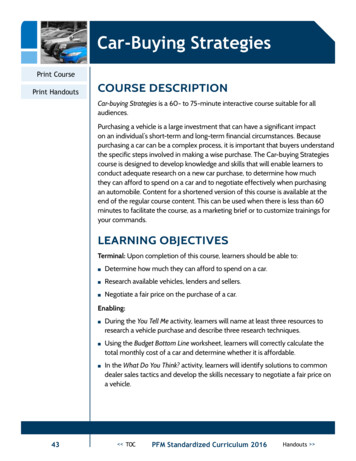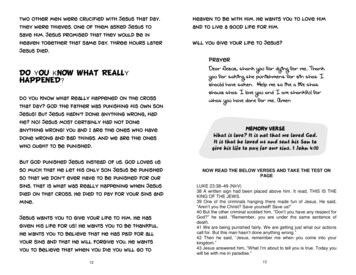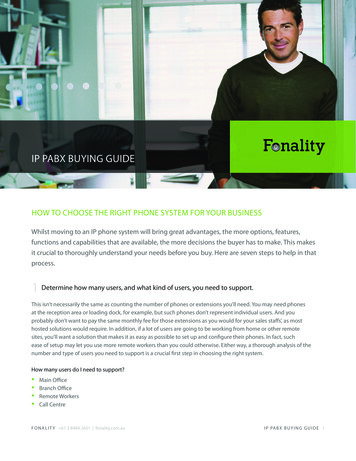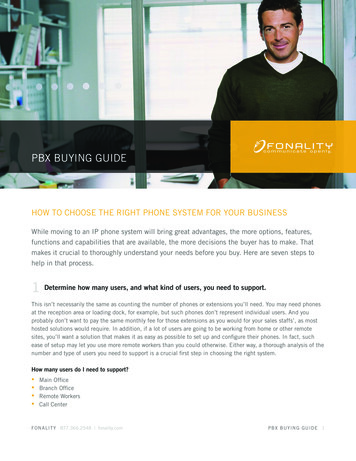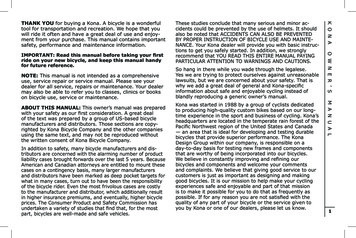
Transcription
NOTE: This manual is not intended as a comprehensiveuse, service repair or service manual. Please see yourdealer for all service, repairs or maintenance. Your dealermay also be able to refer you to classes, clinics or bookson bicycle use, service or maintenance.In addition to safety, many bicycle manufacturers and distributors are concerned with the alarming number of productliability cases brought forwards over the last 5 years. BecauseAmerican and Canadian attorneys are entitled to mount thesecases on a contingency basis, many larger manufacturersand distributors have been marked as deep pocket targets forwhat in many cases, turn out to have been the responsibilityof the bicycle rider. Even the most frivolous cases are costlyto the manufacturer and distributor, which additionally resultin higher insurance premiums, and eventually, higher bicycleprices. The Consumer Product and Safety Commission hasundertaken a variety of studies that find that, for the mostpart, bicycles are well-made and safe vehicles.Kona was started in 1988 by a group of cyclists dedicatedto producing high-quality custom bikes based on our longtime experience in the sport and business of cycling. Kona’sheadquarters are located in the temperate rain forest of thePacific Northwest region of the United States and Canada— an area that is ideal for developing and testing durablebicycles that provide superior performance. The KonaDesign Group within our company, is responsible on aday-to-day basis for testing new frames and componentsthat are worthy of being incorporated into our bicycles.We believe in constantly improving and refining ourbicycles and components and welcome your commentsand complaints. We believe that giving good service to ourcustomers is just as important as designing and makinggood bicycles. It is our mission to help make your cyclingexperiences safe and enjoyable and part of that missionis to make it possible for you to do that as frequently aspossible. If for any reason you are not satisfied with thequality of any part of your bicycle or the service given toyou by Kona or one of our dealers, please let us know.1M A N U A LABOUT THIS MANUAL: This owner’s manual was preparedwith your safety as our first consideration. A great dealof the text was prepared by a group of US-based bicyclemanufacturers and distributors. Those sections are copyrighted by Kona Bicycle Company and the other companiesusing the same text, and may not be reproduced withoutthe written consent of Kona Bicycle Company.So hang in there while you wade through the legalese.Yes we are trying to protect ourselves against unreasonablelawsuits, but we are concerned about your safety. That iswhy we add a great deal of general and Kona-specificinformation about safe and enjoyable cycling instead ofblandly reproducing a generic owner’s manual.O W N E R ’ SIMPORTANT: Read this manual before taking your firstride on your new bicycle, and keep this manual handyfor future reference.These studies conclude that many serious and minor accidents could be prevented by the use of helmets. It shouldalso be noted that ACCIDENTS CAN ALSO BE PREVENTEDBY PROPER INSTRUCTION OF BICYCLE USE AND MAINTENANCE. Your Kona dealer will provide you with basic instructions to get you safely started. In addition, we stronglyrecommend that YOU READ THIS ENTIRE MANUAL PAYINGPARTICULAR ATTENTION TO WARNINGS AND CAUTIONS.K O N ATHANK YOU for buying a Kona. A bicycle is a wonderfultool for transportation and recreation. We hope that youwill ride it often and have a great deal of use and enjoyment from your purchase. This manual contains importantsafety, performance and maintenance information.1
M A N U A LA Special Note for Parents:Like any sport, bicycling involves risk of injury anddamage. By choosing to ride a bicycle, you assumethe responsibility for that risk, so you need to know —and to practice — the rules of safe and responsible ridingand of proper use and maintenance. Proper use andmaintenance of your bicycle reduces risk of injury.O W N E R ’ SThis Manual contains many “Warnings” and “Cautions”concerning the consequences of failure to maintainor inspect your bicycle and of failure to follow safecycling practices.As a parent or guardian, you are responsible for theactivities and safety of your minor child, and that includesmaking sure that the bicycle is properly fitted to the child;that it is in good repair and safe operating condition; thatyou and your child have learned and understand the safeoperation of the bicycle; and that you and your child havelearned, understand and obey not only the applicablelocal motor vehicle, bicycle and traffic laws, but also thecommon sense rules of safe and responsible bicycling.As a parent, you should read this manual, as well asreview its warnings and the bicycle’s functions and operating procedures with your child, before letting your childride the bicycle.K O N AGENERAL WARNING: The combination of thesafety alert symbol andthe word WARNING indicates a potentially hazardoussituation which, if not avoided, could result in seriousinjury or death. The combination of thesafety alert symbol andthe word CAUTION indicates a potentially hazardoussituation which, if not avoided, may result in minor ormoderate injury, or is an alert against unsafe practices. The word CAUTION used without the safety alertsymbol indicates a situation which, if not avoided, couldresult in serious damage to the bicycle or the voiding ofyour warranty.Many of the Warnings and Cautions say “you may losecontrol and fall”. Because any fall can result in seriousinjury or even death, we do not always repeat thewarning of possible injury or death.2Because it is impossible to anticipate every situation orcondition which can occur while riding, this Manual makesno representation about the safe use of the bicycle underall conditions. There are risks associated with the use ofany bicycle which cannot be predicted or avoided, and2which are the sole responsibility of the rider.WARNING: Make sure that your child always wearsan approved bicycle helmet when riding; but also makesure that your child understands that a bicycle helmet isfor bicycling only, and must be removed when not riding.A helmet must not be worn while playing, in play areas,on playground equipment, while climbing trees, or atany time while not riding a bicycle. Failure to follow thiswarning could result in serious injury or death.
A) BIKE FIT2. Is the saddle at the right height? To check, see Section3.B. If you adjust your saddle height, make sure that youfollow the Minimum Insertion instructions in Section 3.B.3. Are saddle and seatpost securely clamped? A correctlytightened saddle will allow no saddle movement in anydirection [see Section 3.B for details].4. Are the stem and handlebars at the right height foryou? If not, see Section 3.C on what you can do about it.5. Can you comfortably operate the brakes? If not, youmay be able to adjust their angle and reach [see Section3.D and 3.E for details].2. Do you have all the other required and recommendedsafety equipment? See Section 2. It’s your responsibilityto familiarize yourself with the laws of the areas whereyou ride, and to comply with all applicable laws.3. Do you know how to correctly operate your wheel quickreleases? Check Section 4.A.1 to make sure. Riding withan improperly adjusted wheel quick release can cause thewheel to wobble or disengage from the bicycle, and causeserious injury or death.4. If your bike has toeclips and straps or clipless “step-in”pedals, make sure you know how they work [see Section4.E]. These pedals require special techniques and skills.Follow the pedal manufacturer’s instructions for use,adjustment and care.5. Does your bike have suspension? If so, check Section4.F. Suspension can change the way a bicycle performs.Follow the suspension manufacturer’s instructions for use,adjustment and care.M A N U A L1. Is your bike the right size? To check, see Section 3.A.If your bicycle is too large or too small for you, you maylose control and fall. If your new bike is not the right size,ask your dealer to exchange it before you ride it.1. Always wear an approved helmet when riding yourbike, and follow the helmet manufacturer’s instructionsfor fit, use and care of your helmet.O W N E R ’ SNOTE: We strongly urge you to read this Manual in itsentirety before your first ride; but at the very least,read and make sure that you understand each pointin this section, and refer to the cited sections onany issue which you don’t completely understand.Please note that not all bicycles have all of the featuresdescribed in this Manual. Ask your dealer to point outthe features of your bicycle.B) SAFETY FIRST!K O N A1. FIRST — BEFORE YOU RIDE6. Do you have “toe overlap”? On smaller framed bicyclesyour toe or toeclip may be able to contact the front wheelwhen a pedal is all the way forward and the wheel isturned [see Section 4.E.1].6. Do you fully understand how to operate your newbicycle? If not, before your first ride, have yourdealer explain any functions or features which youdo not understand.33
M A N U A LO W N E R ’ SK O N AC) MECHANICAL SAFETY CHECKRoutinely check the condition of your bicycle beforeevery ride.Nuts, bolts, screws & other fasteners: Becausemanufacturers use a wide variety of fastener sizes andshapes made in a variety of materials, often differing bymodel and component, it is not possible for this Manual tospecify correct torque (tightening force) for the fastenerson your bicycle. We can tell you the importance of correcttorque, but not the specific torque required for eachfastener on your bicycle. To correctly torque a fastener,a torque wrench must be used. A professional bicyclemechanic with a torque wrench should torque the fastenerson you bicycle. If you choose to work on your own bicycleyou must get correct tightening torque specificationsfrom the bicycle or component manufacturer or from yourdealer. If you need to make an adjustment at home or inthe field, we urge you to exercise care, and to have thefasteners you worked on checked by your dealer as soonas possible.WARNING: Correct tightening force on fasteners— nuts, bolts, screws — on your bicycle is important.Too little force, and the fastener may not holdsecurely. Too much force, and the fastener can stripthreads, stretch, deform or break. Either way, incorrecttightening force can result in component failure, whichcan cause you to loose control and fall.4Make sure nothing is loose. Lift the front wheel off theground by two or three inches, then let it bounce on theground. Anything sound, feel or look loose? Do a visualand tactile inspection of the whole bike. Any loose partsor accessories? If so, secure them. If you’re not sure, ask4someone with experience to check.Tires & Wheels: Make sure tires are correctly inflated[see Section 4.H.1]. Check by putting one hand on thesaddle, one on the intersection of the handlebars andstem, then bouncing your weight on the bike whilelooking at tire deflection. Compare what you see with howit looks when you know the tires are correctly inflated;and adjust if necessary. Tires in good shape? Spin eachwheel slowly and look for cuts in the tread and sidewall.Replace damaged tires before riding the bike. Wheelstrue? Spin each wheel and check for brake clearance andside-to-side wobble. If a wheel wobbles side to side evenslightly, or rubs against or hits the brake pads, take thebike to a qualified bike shop to have the wheel trued.CAUTION: Wheels must be true for the brakes towork effectively. Wheel truing is a skill which requiresspecial tools and experience. Do not attempt to true awheel unless you have the knowledge, experience andtools needed to do the job correctly.Wheel rims clean and undamaged? Make sure the rimsare clean and undamaged at the tire bead and, if youhave rim brakes, along the braking surface. Check tomake sure that any rim wear indicator marking is notvisible at any point on the wheel rim.WARNING: Bicycle wheel rims are subject to wear.Ask your dealer about wheel rim wear. Some wheelrims have a rim wear indicator which becomes visibleas the rim’s braking surface wears. A visible rim wearindicator on the side of the wheel rim is an indicationthat the wheel rim has reached its maximum usablelife. Riding a wheel that is at the end of its usable lifecan result in wheel failure, which can cause you toloose control and fall.
Handlebar Ends: Make sure the handlebar grips aresecure and in good condition. If not, replace them. Makesure the handlebar ends and extensions are plugged. Ifnot, plug them before you ride. If the handlebars havebar end extensions, make sure they are clamped tightenough so you can’t twist them.WARNING: Loose or damaged handlebar gripsor extensions can cause you to lose control and fall.Unplugged handlebars or extensions can cut yourbody, and can cause serious injury in an otherwiseminor accident.VERY IMPORTANT SAFETY NOTE: Please also readand become thoroughly familiar with the importantinformation on the lifespan of your bicycle and itscomponents in Appendix B on Page 35.Familiarize yourself with the braking action of the bike[see Section 4.C]. Test the brakes at slow speed, putting your weight toward the rear and gently applying thebrakes, rear brake first. Sudden or excessive applicationof the front brake could pitch you over the handlebars.Applying brakes too hard can lock up a wheel, which couldcause you to lose control and fall. Skidding is an exampleof what can happen when a wheel locks up.If your bicycle has toeclips or clipless pedals, practicegetting in and out of the pedals [see Section 1.B.4 andSection 4.E].If your bike has suspension, familiarize yourself with howthe suspension responds to brake application and riderweight shifts [see Section 1.B.5 and Section 4.F].M A N U A LHandlebar and Saddle Alignment: Make sure thesaddle and handlebar stem are parallel to the bike’scenter line and clamped tight enough so that you can’ttwist them out of alignment [see Sections 3.B and 3.C].If not, align and tighten them.When you buckle on your helmet and go for your firstfamiliarization ride on your new bicycle, be sure to picka controlled environment, away from cars, other cyclists,obstacles or other hazards. Ride to become familiar withthe controls, features and performance of your new bike.O W N E R ’ SWheel retention system: Make sure the front andrear wheels are correctly secured. See Section 4.ASeat post: If your seat post has an over-center cam actionfastener for easy height adjustment, check that it is properlyadjusted and in the locked position. See Section 4.B.D) FIRST RIDEK O N ABrakes: Check the brakes for proper operation [seeSections 4.C]. Squeeze the brake levers. Are the brakequick-releases closed? All control cables seated andsecurely engaged? Do the brake pads touch the wheel rimwithin an inch of brake lever movement? Can you apply fullbraking force at the levers without having them touch thehandlebar? If not, your brakes need adjustment. Do notride the bike until the brakes are properly adjustedby a professional bicycle mechanic.Practice shifting the gears [see Section 4.D]. Rememberto never move the shifter while pedaling backward,nor pedal backwards after having moved the shifter.This could jam the chain and cause serious damage tothe bicycle.Check out the handling and response of the bike; andcheck the comfort.If you have any questions, or if you feel anythingabout the bike is not as it should be, take the bikeback to your dealer for advice.5
M A N U A LO W N E R ’ SK O N A2. SAFETYA) THE BASICSWARNING: The area in which you ride may requirespecific safety devices. It is your responsibility tofamiliarize yourself with the laws of the state where youride and to comply with all applicable laws, includingproperly equipping yourself and your bike as the lawrequires. Observe all local bicycle laws and regulations.Observe regulations about bicycle lighting, licensing ofbicycles, riding on sidewalks, laws regulating bike pathand trail use, helmet laws, child carrier laws, specialbicycle traffic laws. It’s your responsibility to know andobey the laws.1. Always wear a cycling helmet which meetsthe latest certification standards and followthe helmet manufacturer’s instructions forfit, use and care of your helmet. Most seriousbicycle injuries involve head injuries whichmight have been avoided if the rider hadworn a helmet.WARNING: Failure to wear a helmet when ridingmay result in serious injury or death.2. Always do the Mechanical Safety Check before youget on a bike [see Section 1.C] .3. Be thoroughly familiar with the controls of your bicycle: brakes [see Section 4.C]; pedals [see Section 4.E];shifting [see Section 4.D].64. Be careful to keep body parts and other objects awayfrom the sharp teeth of chainrings; the moving chain; theturning pedals and cranks; and the spinning wheels of7your bicycle.5. Always wear: Shoes that will stay on your feet and will grip thepedals. Never ride barefoot or while wearing sandals. Bright, visible clothing that is not so loose that it can betangled in the bicycle or snagged by objects at the side ofthe road or trail. Protective eyewear, to protect against airborne dirt,dust and bugs — tinted when the sun is bright, clear whenit’s not.6. Don’t jump with your bike. Jumping a bike, particularlya BMX or mountain bike, can be fun; but it can puthuge and unpredictable stress on the bicycle and itscomponents. Riders who insist on jumping their bikesrisk serious damage, to their bicycles as well as tothemselves. Before you attempt to jump, do stunt ridingor race with your bike, read and understand Section 2.F.7. Ride at a speed appropriate for conditions. Increasedspeed means higher risk.B) RIDING SAFETY1. Obey all Rules of the Road and all local traffic laws.2. You are sharing the road or the path with others— motorists, pedestrians and other cyclists. Respecttheir rights.3. Ride defensively. Always assume that others do notsee you.4. Look ahead, and be ready to avoid: Vehicles slowing or turning, entering the road or yourlane ahead of you, or coming up behind you. Parked car doors opening. Pedestrians stepping out. Children or pets playing near the road.
7. Use approved hand signals for turning and stopping.8. Never ride with headphones. They mask traffic sounds andemergency vehicle sirens distract you from concentrating onwhat’s going on around you, and their wires can tangle inthe moving parts of the bicycle, causing you to lose control.9. Never carry a passenger, unless it is a small childwearing an approved helmet and secured in a correctlymounted child carrier or a child-carrying trailer.10. Never carry anything which obstructs your vision oryour complete control of the bicycle, or which couldbecome entangled in the moving parts of the bicycle.15. Never ride your bicycle while under the influence ofalcohol or drugs.16. If possible, avoid riding in bad weather, whenvisibility is obscured, at dusk or in the dark, or whenextremely tired. Each of these conditions increases therisk of accident.C) OFF ROAD SAFETYWe recommend that children not ride on rough terrainunless they are accompanied by an adult.1. The variable conditions and hazards of off-road ridingrequire close attention and specific skills. Start slowly oneasier terrain and build up your skills. If your bike hassuspension, the increased speed you may develop alsoincreases your risk of losing control and falling. Get toknow how to handle your bike safely before tryingincreased speed or more difficult terrain.M A N U A L6. Stop at stop signs and traffic lights; slow down andlook both ways at street intersections. Remember that abicycle always loses in a collision with a motor vehicle,so be prepared to yield even if you have the right of way.14. Observe and yield the right of way.O W N E R ’ S5. Ride in designated bike lanes, on designated bike pathsor as close to the edge of the road as possible, in the direction of traffic flow or as directed by local governing laws.13. Don’t weave through traffic or make any moves thatmay surprise people with whom you are sharing the road.K O N A Pot holes, sewer grating, railroad tracks, expansionjoints, road or sidewalk construction, debris and otherobstructions that could cause you to swerve into traffic,catch your wheel or otherwise cause you to lose controland have an accident. The many other hazards and distractions which canoccur on a bicycle ride.2. Wear safety gear appropriate to the kind of riding youplan to do.3. Don’t ride alone in remote areas. Even when ridingwith others, make sure that someone knows where you’regoing and when you expect to be back.11. Never hitch a ride by holding on to another vehicle.12. Don’t do stunts, wheelies or jumps. If you intend todo stunts, wheelies, jumps or go racing with your bikedespite our advice not to, read Section 2.F, Downhill,Stunt or Competition Biking, now. Think carefully aboutyour skills before deciding to take the large risks that gowith this kind of riding.87
M A N U A LO W N E R ’ SK O N A4. Always take along some kind of identification, so thatpeople know who you are in case of an accident; and takealong a couple of dollars in cash for a candy bar, a cooldrink or an emergency phone call.5. Yield right of way to pedestrians and animals. Ride ina way that does not frighten or endanger them, and stayfar enough away so that their unexpected moves don’tendanger you.6. Be prepared. If something goes wrong while you’reriding off-road, help may not be close.7. Before you attempt to jump, do stunt riding or racewith your bike, read and understand Section 2.F.Off Road RespectObey the local laws regulating where and how you canride off-road, and respect private property. You may besharing the trail with others — hikers, equestrians, othercyclists. Respect their rights. Stay on the designatedtrail. Don’t contribute to erosion by riding in mud or withunnecessary sliding. Don’t disturb the ecosystem bycutting your own trail or shortcut through vegetation orstreams. It is your responsibility to minimize your impacton the environment. Leave things as you found them;and always take out everything you brought in.D) WET WEATHER RIDING8to lose control. To make sure that you can slow down andstop safely in wet conditions, ride more slowly and applyyour brakes earlier and more gradually than you wouldunder normal, dry conditions [see also Section 4.C].E) NIGHT RIDINGRiding a bicycle at night is many times more dangerousthan riding during the day. A bicyclist is very difficult formotorists and pedestrians to see. Therefore, childrenshould never ride at dawn, at dusk or at night. Adultswho chose to accept the greatly increased risk of ridingat dawn, at dusk or at night need to take extra care bothriding and choosing specialized equipment which helpsreduce that risk. Consult your dealer about night ridingsafety equipment.WARNING: Reflectors are not a substitute forrequired lights. Riding at dawn, at dusk, at night orat other times of poor visibility without an adequatebicycle lighting system and without reflectors isdangerous and may result in serious injury or death.Bicycle reflectors are designed to pick up and reflectstreet lights and car lights in a way that may help you tobe seen and recognized as a moving bicyclist.WARNING: Wet weather impairs traction, brakingand visibility, both for the bicyclist and for othervehicles sharing the road. The risk of an accident isdramatically increased in wet conditions.CAUTION: Check reflectors and their mountingbrackets regularly to make sure that they are clean,straight, unbroken and securely mounted. Have yourdealer replace damaged reflectors and straighten ortighten any that are bent or loose.Under wet conditions, the stopping power of your brakes(as well as the brakes of other vehicles sharing the road)is dramatically reduced and your tires don’t grip nearlyas well. This makes it harder to control speed and easier 9The mounting brackets of front and rear reflectors areoften designed as brake straddle cable safety catcheswhich prevent the straddle cable from catching on the tiretread if the cable jumps out of its yoke or breaks.
While riding at dawn, at dusk or at night: Ride slowly. Avoid dark areas and areas of heavy or fast-moving traffic. Avoid road hazards. If possible, ride on familiar routes.Whether you call it Aggro, Hucking, Freeride, North Shore,Downhill, Jumping, Stunt Riding, Racing or something else:by engaging in this sort of extreme, aggressive riding youvoluntarily assume an increased risk of injury or death.Not all bicycles are designed for these types of riding,and those that are may not be suitable for all types ofaggressive riding. Check with your dealer or the bicycle’smanufacturer about the suitability of your bicycle beforeengaging in extreme riding.When riding fast down hill, you can reach speeds seen onmotorcycles, and therefore face similar hazards and risks.Have your bicycle and equipment carefully inspected by aqualified mechanic and be sure it is in perfect condition.Consult with expert riders and race officials on conditionsand equipment advisable at the site where you plan to ride.Wear appropriate safety gear, including an approved fullface helmet, full finger gloves, and body armor. Ultimately,it is your responsibility to have proper equipment and to befamiliar with course conditions.WARNING: Although many catalogs,advertisements and articles about bicycling depictriders engaged in extreme riding, this activity isextremely dangerous, increases your risk of injuryor10 death, and increases the severity of any injury.M A N U A L Purchase and install battery or generator powered headand tail lights which meet all regulatory requirements andprovide adequate visibility. Wear light colored, reflective clothing and accessories,such as a reflective vest, reflective arm and leg bands,reflective stripes on your helmet, flashing lights attachedto your body and/or your bicycle . any reflective deviceor light source that moves will help you get the attentionof approaching motorists, pedestrians and other traffic. Make sure your clothing or anything you may be carrying on the bicycle does not obstruct a reflector or light. Make sure that your bicycle is equipped with correctlypositioned and securely mounted reflectors.F) EXTREME, STUNT OR COMPETITION RIDINGO W N E R ’ SIf you choose to ride under conditions of poor visibility,check and be sure you comply with all local laws aboutnight riding, and take the following strongly recommended additional precautions:If riding in traffic: Be predictable. Ride so that drivers can see you andpredict your movements. Be alert. Ride defensively and expect the unexpected. If you plan to ride in traffic often, ask your dealerabout traffic safety classes or a good book on bicycletraffic safety.K O N AWARNING: Do not remove the front or rearreflectors or reflector brackets from your bicycle.They are an integral part of the bicycle’s safetysystem. Removing the reflectors may reduce yourvisibility to others using the roadway. Being struck byother vehicles may result in serious injury or death.The reflector brackets may protect you from the brakestraddle cable catching on the tire in the event ofbrake cable failure. If a brake straddle cable catcheson the tire, it can cause the wheel to stop suddenly,causing you to loose control and fall.9
M A N U A LO W N E R ’ SK O N ARemember that the action depicted is being performedby professionals with many years of training andexperience. Know your limits and always wear ahelmet and other appropriate safety gear. Even withstate-of-the-art protective safety gear, you could beseriously injured or killed when jumping, stunt riding,riding downhill at speed or in competition.CAUTION: Bicycles and bicycle parts havelimitations with regard to strength and integrity, andthis type of riding can exceed those limitations.We recommend against this type of riding because of theincreased risks; but if you choose to take the risk, at least: Take lessons from a competent instructor first. Start with easy learning exercises and slowly developyour skills before trying more difficult or dangerous riding Use only designated areas for stunts, jumping, racing orfast downhill riding Wear a full face helmet, safety pads and othersafety gear. Understand and recognize that the stresses imposed onyour bike by this kind of activity may break or damagepartsof the bicycle and void the warranty. Take your bicycle to your dealer if anything breaks orbends. Do not ride your bicycle when any part is damaged.If you ride downhill at speed, do stunt riding or ride incompetition, know the limits of your skill and experience.Ultimately, avoiding injury is your responsibility.G) CHANGING COMPONENTS ORADDING ACCESSORIES10There are many components and accessories availableto enhance the comfort, performance and appearance ofyour bicycle. However, if you change components or addaccessories, you do so at your own risk. The bicycle’smanufacturer may not have tested that component oraccessory for compatibility, reliability or safety on yourbicycle. Before installing any component or accessory,including a different size tire, make sure that it iscompatible with your bicycle by checking with your dealer.Be sure to read, understand and follow the instructionsthat accompany the products you purchase for yourbicycle. See also Appendix B [p.35].WARNING: Failure to confirm compatibility,properly install, operate and maintain any componentor accessory can result in serious injury or death.CAUTION: Changing the components on yourbike may void the warranty. Refer to your warranty,and check with your dealer before changing thecomponents on your bike.3. FITNOTE: Correct fit is an essential element of bicyclingsafety, performance and comfort. Making theadjustments to your bicycle which result in correctfit for you
fastener on your bicycle. To correctly torque a fastener, a torque wrench must be used. A professional bicycle mechanic with a torque wrench should torque the fasteners on you bicycle. If you choose to work on your own bicycle you must get correct tightening torque specifications from the bicycle or com
